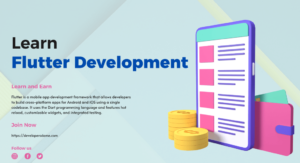In recent years, Flutter has emerged as a popular cross-platform mobile development framework for building high-performance applications. With its modern approach and powerful features, it offers developers a lot of flexibility and ease of use. However, building scalable and maintainable applications with Flutter requires an understanding of architecture patterns, app structure, and state management. In this guide, we’ll explore some of the best practices and patterns for building Flutter applications that are easy to scale and maintain.
Contents
What is Flutter?
- Flutter is a mobile app development framework that allows developers to build natively compiled applications for mobile, web, and desktop from a single codebase.
- It was created by Google and is open-source, which means that anyone can use it for free.
- Flutter uses the Dart programming language and is known for its fast development cycle, thanks to features like hot reload.
- It also has a rich set of built-in widgets and tools for building beautiful and responsive user interfaces.
Key Features of Flutter:
- Fast development cycle with hot reload
- Support for building apps across multiple platforms
- Rich set of built-in widgets and tools for building user interfaces
What is the architecture of Flutter?
- Flutter’s architecture includes everything needed to build an app, including the UI and app logic.
- At the core of Flutter’s architecture is the Flutter engine, which is written in C++ and is responsible for rendering the UI and executing the app’s logic.
- On top of the Flutter engine is the Flutter framework, which is written in Dart and includes a rich set of customizable widgets and tools for building the UI and app logic.
- The Flutter framework also includes support for integration with other platforms and services, as well as a fast development cycle with hot reload.
What are some common Flutter Architecture patterns?
There are several architecture patterns commonly used in Flutter, including Model-View-Controller (MVC), Model-View-ViewModel (MVVM), and Clean Architecture. Each pattern has its own advantages and trade-offs, and the choice of the pattern depends on the specific needs of your application.
What is the recommended app structure for a Flutter application?
A recommended app structure for Flutter applications is to separate your code into different layers, including data, domain, and presentation layers. The data layer handles interactions with data sources, such as APIs or databases. The domain layer contains business logic and interacts with the data layer to retrieve and manipulate data. Finally, the presentation layer contains the UI code, which interacts with the domain layer to display data to the user.
How do you manage the state in Flutter?
Flutter offers several options for managing state, including setState(), BLoC (Business Logic Component), Redux, and Provider. The choice of state management technique depends on the complexity of your application and your personal preferences. For example, setState() is suitable for small applications with simple states, while BLoC or Redux may be better for larger applications with complex states.
How do you ensure that your Flutter application is scalable and maintainable?
To ensure that your Flutter application is scalable and maintainable, you should follow best practices for architecture, app structure, and state management. You should also write clean and well-documented code, use appropriate design patterns, and follow industry-standard coding conventions. Additionally, you should regularly review and refactor your code to remove technical debt and ensure that your application remains maintainable over time.
Overall, Flutter is a powerful and comprehensive app development framework that allows developers to build high-quality, cross-platform apps quickly and efficiently. We hope this beginner’s guide to Flutter has given you a good understanding of the framework and its architecture. Happy coding!
You may like:
Introduction to Flutter and the Dart Programming Language
Flutter framework and its architecture Flutter framework and its architecture

Pingback: Why choose Flutter for your mobile app project?